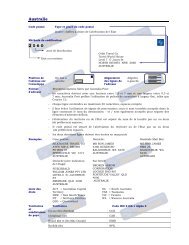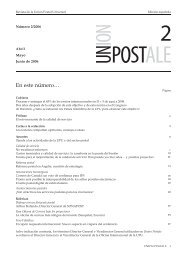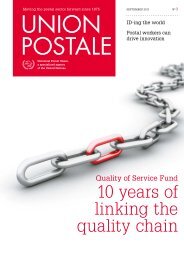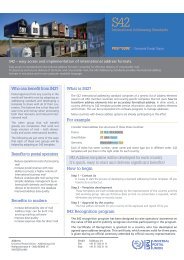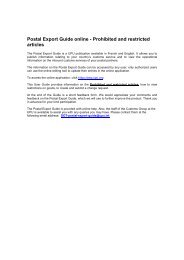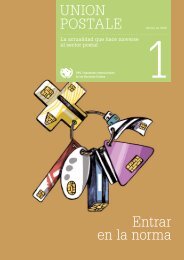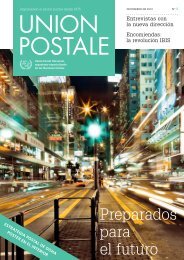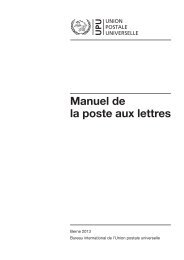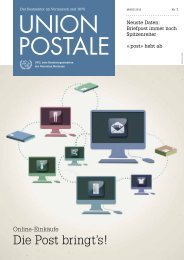Catalogue of UPU Standards - Universal Postal Union
Catalogue of UPU Standards - Universal Postal Union
Catalogue of UPU Standards - Universal Postal Union
Create successful ePaper yourself
Turn your PDF publications into a flip-book with our unique Google optimized e-Paper software.
S39<br />
S43<br />
S43a<br />
S43b<br />
S52<br />
S53<br />
S57<br />
Trusted Time Stamp<br />
The standardisation <strong>of</strong> the trusted time stamp can be seen as the electronic replacement <strong>of</strong> the<br />
present postmark on regular mail. As such, the service requires electronic security features to<br />
reproduce some characteristics <strong>of</strong> the traditional postmark such as a time and date stamp given by<br />
a postal operator acting as a trusted third party in a communication.<br />
The service is a first example <strong>of</strong> a Global <strong>Postal</strong> Trust Service (GPTS) allowing <strong>Postal</strong> operators to<br />
bring e-mail up to the same level <strong>of</strong> acceptance that hard-copy mail currently enjoys. Via the trusted<br />
time stamp service, e-mail messages will be given, by the <strong>Postal</strong> operators acting as a trusted third<br />
party, a tamper-detection feature with a secure time and date stamp (i.e. the trusted time stamp).<br />
Secure electronic postal services (SEPS) interface specification<br />
Part A: Concepts, schemas and operations<br />
This document specifies a standard XML interface that will enable s<strong>of</strong>tware applications to call a<br />
secured electronic postal service (SePS), provided by a postal operator. It also describes the<br />
functionality and edit rules <strong>of</strong> the actual technical specification artifacts, which are represented by<br />
an XML Schema (XSD) and an associated Web Services Definition Language (WSDL)<br />
specification.<br />
Part B: EPCM Service<br />
This document specifies a secured electronic postal service, referred to as the Electronic <strong>Postal</strong><br />
Certification Mark (EPCM) service, which provides a chain <strong>of</strong> evidence, stored by an operator as a<br />
trusted third party, to prove the existence <strong>of</strong> an electronic event, for a certain content, at a certain<br />
date and time, and involving one or more identified parties.<br />
Functional specification for postal registered electronic mail<br />
This standard defines the functional specification <strong>of</strong> a secure electronic postal service, referred to<br />
as the postal registered electronic mail or PReM service. PReM provides a trusted and certified<br />
electronic mail exchange between mailer, designated operators and addressee/mailee. In addition,<br />
evidence <strong>of</strong> corresponding events and operations within the scope <strong>of</strong> PReM will be generated and<br />
archived for future attestation.<br />
Exchange <strong>of</strong> name and address data<br />
This standard facilitates the electronic communication <strong>of</strong> international name and address data sets<br />
from mailer to postal operator; from postal operator to postal operator; from postal operator to<br />
mailer and between mailers. It supports such communication both in the form <strong>of</strong> S42 data elements<br />
and in the form used in printed postal addresses. The standard is based on two W3C XML<br />
Schemas and relies on S42 for definitions <strong>of</strong> elements, element sub-types and country based<br />
templates.<br />
Statement <strong>of</strong> mailing submission<br />
This standard specifies a methodology that allows postal operators to define statements <strong>of</strong> mailing<br />
submission customised according to their environment and applications. It defines information that<br />
could be collected within the mailer’s domain and transmitted to the postal domain to support<br />
processing applications related to major postal functions, namely operations, finance and<br />
marketing. It also defines the organisation <strong>of</strong> data originating in the mailer’s domain into messages<br />
by describing data content, format and communication protocols and provides a detailed analysis<br />
and recommendations for implementing countermeasures against application level security threats,<br />
particularly those relating to postal revenue protection in controlled mail entry settings.<br />
© <strong>UPU</strong> 2014 – All rights reserved 13



